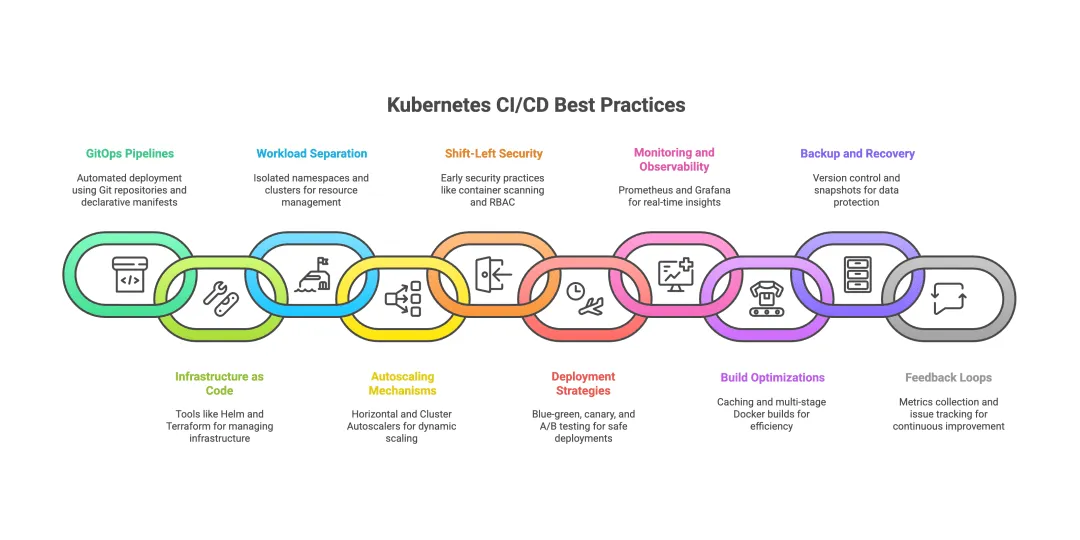October 17, 2025
Automate Kubernetes CI/CD Pipelines: Best Tools and Practices

By Improwised Editorial Team
Improwised Technologies Pvt. Ltd.
Continuous Integration and Continuous Deployment (CI/CD) is a software development methodology that accelerates delivery cycles and enhances the quality of deployments in today’s rapidly evolving software development environment. Continuous Integration and Continuous Deployment pipelines facilitate the automation of code integration, testing, and deployment processes. This enhances the efficiency and dependability of the process.

The platform engineering team improves these factors by implementing standardized practices for continuous integration and continuous delivery across all Kubernetes installations. This allows developers to function autonomously while maintaining smooth process execution, ensuring that team deployments are carried out with assurance and effectiveness.
This article details the functionality of Kubernetes CI/CD pipelines in streamlining automation, reducing manual tasks, and enhancing the efficiency and quality of application releases for developers. The engineers can also learn about trending practices for CI/CD and Kubernetes.
Why is CI/CD important for Kubernetes?
In the case of manual Kubernetes deployments, one faces various challenges such as configuration complexity, scaling headaches, and inconsistent environments, which result in errors and slower release cycles.
You can get the following with Kubernetes-native CI/CD pipelines:
- Making deployment processes automatic
- They cut down on the number of stages that need to be done manually, which means there are fewer mistakes.
- Faster cycles from deployment to production
- Consistency makes things more reliable.
This speeds up new ideas while keeping the environment stable and ready for production.
Traditional vs Kubernetes-Native CI/CD Approaches
Before Kubernetes-native pipelines, teams utilized CI/CD tools that ran on their dedicated servers or on SaaS services. These only operated with Kubernetes in a limited way, and they needed to be deployed manually or with custom scripts.
Kubernetes-native methods run CI/CD tools right inside Kubernetes clusters using custom resources or operators. This makes it feasible to:
- Seamless integration with Kubernetes APIs for deployment and scaling.
- Declarative configuration and GitOps drive automation
- Enhanced scalability and resource isolation
- Simplified management with Kubernetes-native security and RBAC.
If teams grasp the difference between the two, they can better plan how to shift from old pipelines to ones that work better with Kubernetes.
Key Components of a Kubernetes CI/CD Pipeline
Integration of Source Control
- Git or GitOps workflows manage both the codebase and infrastructure as code.
- Git stores declarative manifests that let you do versioning and roll back changes.
Automation of Building and Testing
- Kubernetes runs CI tools like Jenkins X, Tekton, and GitLab CI.
- Automated builds of container images with improved caching and parallelism
Safe Container Registries
- Vulnerability scanning on trusted registries like Harbor or Docker Hub
- Artifact signing and role-based access make sure that images are safe.
Delivery and Deployment of Artifacts
- Helm charts, Kustomize, or bare manifests that are deployed declaratively
- Managing namespaces and resource quotas for cost control and isolation
Control of monitoring, rollbacks, and releases
- Observability stack with Prometheus, Grafana, and tracing tools that look at the health of the pipeline
- Automated rollback based on metrics or manual triggers for resiliency
Running CI/CD Pipelines Directly on Kubernetes
Implementing CI/CD solutions within Kubernetes clusters guarantees seamless integration with your environments and enhances scalability. As an illustration:
- Jenkins has been deployed using Helm charts, with Kubernetes agents properly configured.
- Tekton pipelines are established as custom resources and operate natively.
- ArgoCD or FluxCD is implemented for continuous GitOps reconciliation within the cluster.
This method minimizes environmental discrepancies and streamlines pipeline functionalities, facilitating infrastructure as code for applications and pipelines alike.
Resource & Namespace Management for CI/CD Workloads
Optimized Kubernetes CI/CD necessitates robust infrastructure planning.
- Implement dedicated namespaces for CI/CD workloads to ensure resource and permission isolation.
- Implement resource quotas and limits to mitigate pipeline overconsumption and ensure cluster stability.
- Implement autoscaling for CI agents and build pods according to demand.
- Evaluate the use of distinct clusters for high-scale or sensitive pipelines.
This improves dependability, streamlines expenses, and strengthens security measures.
Essential Tools and Technologies
Here is a table listing the best Kubernetes CI/CD tools:
| Tool | Key Strengths | Ideal Use Case |
|---|---|---|
| ArgoCD | GitOps-centric, declarative deployment | GitOps workflows, multi-cluster |
| Jenkins X | Kubernetes-native Jenkins alternative | Complex pipelines, multi-stage builds |
| Tekton | Kubernetes CRD-based pipeline engine | Custom pipeline workflows |
| FluxCD | Continuous GitOps reconciliation | Lightweight GitOps automation |
| Spinnaker | Advanced release orchestration, multi-cloud | Enterprises needing sophisticated deployment control |
| Devtron | Developer-centric CI/CD platform | Simplified DevOps for teams |
For resource tuning and automated deployment, tools like KubeShim and Kubernetes Autoscaler improve pipeline efficiency.
Also Read: List of Top 10 Kubernetes-Native Platform Engineering Companies
Observability & Monitoring in Kubernetes CI/CD
Monitoring CI/CD pipelines is essential:
- Utilize Prometheus and Grafana for monitoring pipeline metrics such as build duration, failure rates, and resource utilization.
- Utilizing sophisticated tools such as eBPF tracers enables the identification of bottlenecks and enhances deployment efficiency.
- Utilizing centralized logging through Elasticsearch or Loki enhances the troubleshooting process.
- Alerting systems initiate rollbacks or inform teams of failures.
Observability facilitates ongoing enhancement and ensures operational safety.
Advanced Deployment Strategies
Contemporary Kubernetes CI/CD incorporates:
- Blue-Green Deployments: Achieve zero downtime by redirecting traffic between identical environments.
- Canary Releases: involve the gradual exposure of new versions to identify issues at an early stage.
- Feature Flagging: allows for the separation of deployment from release, enabling the testing of new features. securely
- Multi-Stage Pipelines: Systematic advancement through environments utilizing both manual and automated approval processes.
These methodologies reduce potential hazards and enhance user interaction.
Security and Networking in CI/CD
Robust security integration guarantees reliability:
- Implement role-based access control to manage permissions within the pipeline.
- Implement service meshes such as Istio or Linkerd to facilitate encrypted communication between services during release cycles.
- Incorporate vulnerability scanning for container images at the initial stages of continuous integration.
- Implement network policies to restrict the communication range of pipeline workloads.
Proactive security integrates compliance measures and mitigates incident risk.
Emerging Trends & AI in Kubernetes CI/CD
The field is evolving with innovative approaches:
- AI and ML algorithms predicting build failures or optimizing resource allocation
- Dependency caching and artifact promotion are speeding up CI runs.
- Enhanced GitOps workflows incorporating automated drift detection and remediation
- Automated compliance checks embedded directly in pipelines
Staying current with trends ensures competitive advantages.
Platform Engineering Use Cases
Improwised Technologies has enabled clients through the implementation of extensive Kubernetes CI/CD solutions that:
- Minimize manual operational activities
- Activate self-service developer environments
- Enhance deployment speed through secure implementation strategies.
- Deliver pipelines that are compliant and ready for audits to meet enterprise requirements.
The observed outcomes illustrate the effectiveness of properly implemented CI/CD processes.
Also Read: Kubernetes and Platform Engineering: A Match Made in Cloud Heaven
Best Practices for CI/CD and Kubernetes
Setting up CI/CD pipelines with Kubernetes isn’t just about installing tools; it requires strict practices to ensure security, scalability, reliability, and better productivity for developers. Adhering to established best practices enables organizations to maximize the benefits of Kubernetes automation, GitOps workflows, and automated resource tuning tools, facilitating the creation of resilient, efficient, and secure pipelines from code to production. Here are the essential best practices to enhance your Kubernetes CI/CD implementation:
-
Implement GitOps Pipelines for Declarative Deployments
Utilize Git as the definitive repository for all application code and Kubernetes manifests. Utilize pull-based CI/CD workflows through tools such as ArgoCD or FluxCD to ensure cluster state consistency, reduce configuration drift, and facilitate version-controlled rollbacks. -
Utilize Infrastructure as Code (IaC) tools
Oversee Kubernetes resource definitions and pipeline configurations utilizing Helm charts, Kustomize, or Terraform providers. This approach guarantees a consistent and verifiable environment setup, along with seamless recovery in the event of pipeline errors. -
Separate CI/CD workloads by utilizing dedicated namespaces or clusters.
Execute CI/CD tooling within distinct Kubernetes namespaces or potentially across different clusters to avoid resource conflicts with production workloads. Implement quotas and limits in Kubernetes for pipeline components to prevent “noisy neighbor” issues and maintain cluster stability. -
Deploy Automated Kubernetes Resource Optimization
Implement autoscaling capabilities such as Horizontal Pod Autoscaler and Cluster Autoscaler, along with dedicated resource tuning tools, to dynamically modify resource allocation throughout CI/CD processes. This ensures that build and deployment durations remain efficient while managing infrastructure expenses effectively. -
Incorporate security measures from the outset through shift-left methodologies.
Integrate container image scanning, conduct vulnerability assessments, and perform compliance checks within CI pipeline stages utilizing tools such as Trivy or Clair. Utilize Kubernetes RBAC and network policies to restrict permissions and implement least-privilege access for CI/CD service accounts. -
Develop Advanced Deployment Methodologies
Implement blue-green, canary, or A/B deployment strategies utilizing Kubernetes-native tools like Spinnaker or Argo Rollouts. These strategies mitigate risk through the incremental deployment of changes, while facilitating rapid automated rollbacks in the event of an issue. -
Activate Comprehensive Monitoring and Observability
Oversee CI/CD pipelines and Kubernetes clusters utilizing Prometheus, Grafana, and various tracing tools. Examine build durations, failure rates, and infrastructure utilization to enhance pipeline performance and reliability on an ongoing basis. -
Implement Cache Dependencies and Enhance Build Layers
Enhance CI performance by efficiently caching dependencies such as npm and Maven, along with optimizing Docker layer caching. Utilize multi-stage Docker builds and artifact repositories to reduce unnecessary downloads and enhance the speed of container image generation. -
Implement Backup Solutions and Develop Disaster Recovery Strategies
Consistently ensure the backup of essential pipeline configurations, Kubernetes manifests, and storage volumes. Implement version control and automated snapshots to facilitate rapid recovery from unintentional deletions or cluster failures, thereby maintaining pipeline continuity. -
Streamline Feedback Mechanisms and Ongoing Enhancement
Continuously gather pipeline metrics and user feedback to enhance the build, test, and deployment phases. Implement automated notifications and integrate with issue-tracking systems to expedite the resolution of pipeline failures and deployment challenges.
Adhering to these best practices enables teams to effectively implement Kubernetes automation, utilize GitOps pipeline methodologies, and leverage the most efficient Kubernetes CI/CD tools, resulting in expedited, secure, and dependable software delivery pipelines.
Conclusion
Improwised Technologies’ experts in Kubernetes CI/CD integrations help various companies to innovate faster, boost developer agility, and elevate operational safety. Our tailored consultations design pipelines that fit your organization’s unique business contexts and technical needs. With our years of experience, we are known to provide service within a quick time frame.
Contact our platform engineering team today and transform your Kubernetes deployments into automated, reliable, and scalable CI/CD pipelines!
Frequently Asked Question
Get quick answers to common queries. Explore our FAQs for helpful insights and solutions.

November 19, 2025
Unlocking Developer Potential: How Platform Engineering Transforms Developer Experience

By Shyam Kapdi
Improwised Technologies
Pvt. Ltd.


By Shyam Kapdi
Improwised Technologies
Pvt. Ltd.

November 14, 2025
How to Build a High-Impact Internal Developer Platform: Step-by-Step Blueprint, Tools, and Best Practices

By Shyam Kapdi
Improwised Technologies
Pvt. Ltd.
Optimize Your Cloud. Cut Costs. Accelerate Performance.
Struggling with slow deployments and rising cloud costs?
Our tailored platform engineering solutions enhance efficiency, boost speed, and reduce expenses.
